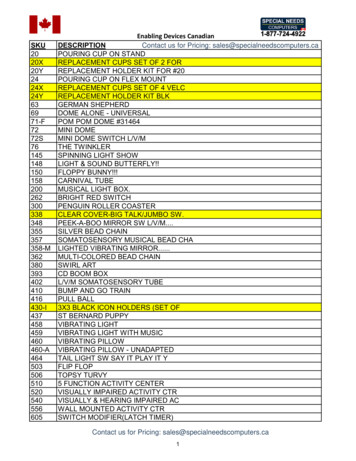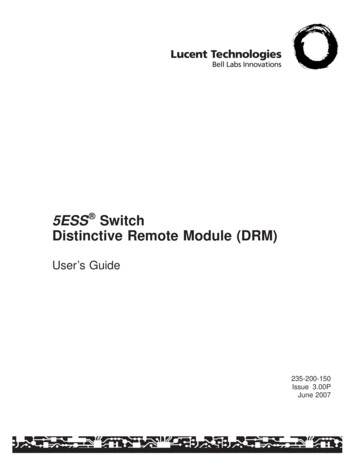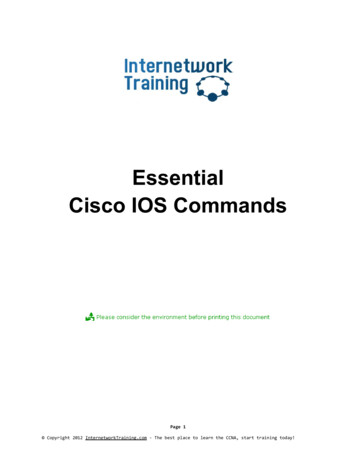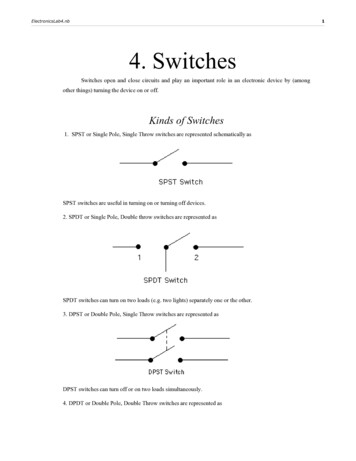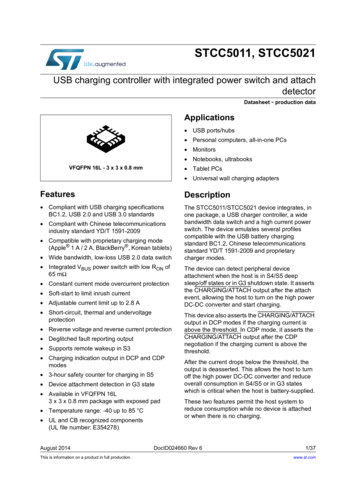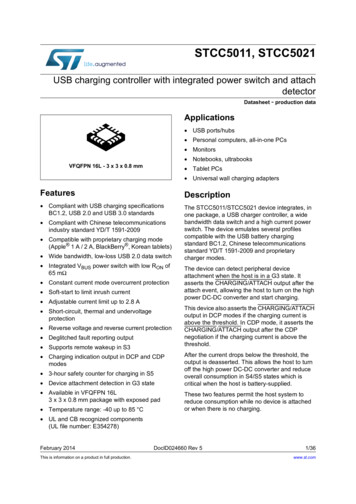
Transcription
Jaqen: A High-Performance Switch-Native Approach for Detecting and MitigatingVolumetric DDoS Attacks with Programmable SwitchesZaoxing Liu?Hun Namkung§Georgios Nikolaidis†Jeongkeun Lee†Changhoon Kim† Xin Jin/ Vladimir Braverman‡ Minlan Yu Vyas Sekar§? Boston University† Intel, Barefoot Switch Division/ Peking University‡ Johns Hopkins University Harvard University § Carnegie Mellon UniversityAbstractThe emergence of programmable switches offers a new opportunity to revisit ISP-scale defenses for volumetric DDoS attacks. In theory, these can offer better cost vs. performance vs.flexibility trade-offs relative to proprietary hardware and virtual appliances. However, the ISP setting creates unique challenges in this regard—we need to run a broad spectrum of detection and mitigation functions natively on the programmableswitch hardware and respond to dynamic adaptive attacks atscale. Thus, prior efforts in using programmable switches thatassume out-of-band detection and/or use switches merely asaccelerators for specific tasks are no longer sufficient, andas such, this potential remains unrealized. To tackle thesechallenges, we design and implement Jaqen, a switch-nativeapproach for volumetric DDoS defense that can run detectionand mitigation functions entirely inline on switches, without relying on additional data plane hardware. We designswitch-optimized, resource-efficient detection and mitigationbuilding blocks. We design a flexible API to construct a widespectrum of best-practice (and future) defense strategies thatefficiently use switch capabilities. We build a network-wideresource manager that quickly adapts to the attack posturechanges. Our experiments show that Jaqen is orders of magnitude more performant than existing systems: Jaqen can handlelarge-scale hybrid and dynamic attacks within seconds, andmitigate them effectively at high line-rates (380 Gbps).1IntroductionDistributed Denial of Service (DDoS) attacks continue to bea destructive force in today’s Internet [1]. Despite decades ofwork, volumetric attacks continue to be a severe threat, withgrowing attack volumes and types. In this respect, InternetService Providers (ISPs), as the infrastructure to route Internettraffic, are at a unique vantage point to combat such volumetricattacks without interrupting client-side services.In this context, programmable switching hardware hasemerged as a promising means to enable defenses againstvolumetric DDoS attacks [2–7]. In particular, they promisebetter cost, performance, and flexibility tradeoffs, comparedto traditional solutions. For instance, proprietary/fixed hardware appliances are expensive, have limited capabilities, andhard to upgrade in the field (e.g., [8, 9]). On the other hand,software appliances (e.g., [10]), while dynamic and reprogrammable, incur large latency, and are not efficient for largeattacks. In addition, both classes of approaches entail high capital costs [9–11]. In contrast, programmable switches promisehigh line-speed guarantees (e.g., 6.5Tbps [12]), sufficient programmability (e.g., P4 [13]), and lower cost (Table 1).Realizing this promise, however, is easier said than done,and the ISP setting creates unique and fundamental challengesthat existing solutions do not address. Given that ISPs are inline and on the critical path of large attack traffic volumes, weneed to support a broad spectrum of detection and mitigationnatively on the programmable switches. Unfortunately, existing programmable switch-based solutions fail on one or moreof these dimensions [3, 4, 6, 7, 14]. Specifically, existing efforts rely on out-of-band detection with the need to reroutetraffic to separate monitoring infrastructure, which entails additional latency and cost [15–17]. Furthermore, many of thesesupport a small number of mitigation functions [4, 6, 7, 14],or do so in an inefficient manner that exhausts the limitedswitch resources and can disrupt legitimate connections [3].To this end, we present Jaqen, a switch-native detectionand mitigation system that handles a broad spectrum of volumetric attacks [18] within ISPs. Unlike prior solutions, Jaqencompletely runs on programmable switches (i.e., switchnative) and fully leverages their capabilities for accurate detection and fast response as attack postures change. Jaqen isan agile system that dynamically distributes detection and mitigation capabilities in a network-wide setting when availableswitch resources, attack types, and traffic volumes change.Our overarching goal is to design a secure-yet-practicaldefense system, working within the limited switch chip resources (e.g., O (10MB) SRAM and limited accesses to theSRAM [12]). To see why this is challenging, consider twonatural strawman solutions. First, to cover many attacks, wecan consider running all potential detection and mitigationmechanisms on the switch. Unfortunately, this is infeasibledue to resource constraints. Alternatively, we can run only asubset of detection and mitigation modules. However, this creates blind spots, where we do not have visibility into ongoingattacks, especially when attacks can dynamically change; i.e.,the detection module checks for SYN floods but the attackerchanges to a DNS amplification that goes undetected.
As a practical and robust alternative to these strawman solutions, we argue for a broad-spectrum always-on detection andon-demand mitigation design approach. That is, the detectionlogic must continuously (i.e., always-on) identify all attacksin our scope to avoid blind spots in face of dynamic attacks.Rather than enable all mitigation modules, we install themas needed (i.e., on demand) to optimize hardware resourceusage. Given this high-level design philosophy, we addresskey algorithmic and system design challenges in Jaqen.(1) Designing switch-native detection with high coverage:We build a switch-native, broad-coverage detector for ISPsby bridging universal sketch techniques in network monitoring [19, 20] and general DDoS detection. Instead ofcrafting multiple custom algorithms to achieve coverage(e.g., [15, 21–27]), universal sketches make it possible totrack a broad range of current and unforeseen metrics witha single algorithm. We design the detector with two layers:Data plane—universal sketches as data plane primitivesthat can be pulled by the controller or configured as eventtriggers. Control plane—detection API for users to configure the sketches, query relevant metrics, and computedetection decisions.(2) Flexible and performant switch-native mitigation: Weidentify a unified abstraction to implement mitigation withthree interactive components: (1) filtering to drop, allow,or rate limit packets, (2) analysis to identify malicious traffic, and (3) update to the filtering when needed. For eachcomponent, we design a library of relevant mitigation functions with API based on best-practice mechanisms (e.g.,intentional SYN drop [28] and DNS matching [23]) usingswitch-optimized logic and probabilistic structures [29–33].Thus, constructing sophisticated (and possibly new) mitigation strategies will be like flexibly combining differentbuilding blocks on hardware using our API.(3) Network-wide management to handle dynamic attacks:When attack postures change, Jaqen needs to compute anew resource allocation to redirect traffic to other availableswitches with the smallest rerouting cost. We formulatethis as a Mixed-Integer Program (MIP). However, for largeISPs, a state-of-the-art solver could take a long time (10s ofmin) to finish. Thus, we design a responsive near-optimalheuristic that is 3-4 orders of magnitude faster.We implement Jaqen in Barefoot Tofino switches [12] using the P4 language [13]. Our evaluation, performed on a setof one 6.5 Tbps programmable switch and eleven 40 Gbpsservers, shows that Jaqen (1) accurately detects the attack typeand estimates the attack volume with 97% accuracy when theattack traffic is not negligible ( 1.5% of tested 380-Gbpsthroughput), (2) reacts to hybrid and dynamic DDoS attackswithin 15-sec (including 10-sec detection period), and (3) mitigates the attack traffic with low false positives and negatives(varying from 0.0 to 0.072). Although our testbed only generates 380 Gbps traffic due to limited equipment, Jaqen withone switch can potentially handle Tbps-level attacks withoutinterrupting legitimate users.Contributions and roadmap. In summary, this paper makesthe following contributions: Highlighting the requirements for ISP-based defense andidentifying security limitations of existing P4-based defense solutions in the ISP setting. (§2) An integrated DDoS detection and mitigation frameworkentirely on programmable switches for defending volumetric attacks in ISPs. (§3) A broad-spectrum switch-native detector using universalsketching techniques and a library of highly optimizedmitigation primitives for developers to write state-of-theart and possibly new mitigation strategies in P4. (§4,§5) A network-wide resource manager that optimally deploysdetection and mitigation modules in the network. (§6). An end-to-end system realization of Jaqen (§7) and demonstration of its effectiveness in handling real-world largescale dynamic attack. (§8)2Background and MotivationIn this section, we begin by highlighting the requirements forISP-centric defense and the opportunities that programmableswitches bring. We then discuss existing defense solutionsand highlight their shortcomings.2.1Requirements for ISP-centric DefenseISPs own a large hierarchy of switches and routers to routeuser traffic to and from destinations, but usually do not accessapplication-level user information. Given this nature, defending volumetric attacks in ISPs is appealing and ISP-based defense systems shall consider the following requirements: Impact on benign traffic: For service providers, the overarching goal is to improve user experiences for legitimateusers. Thus, ISP-based defenses must not interrupt or droplegitimate user connections and shall not add large extra latency to benign traffic. Ideally, ISPs should limit the amountof traffic rerouted to out-of-band detection and scrubbingcenters, and limit the usage of slow packet processing elements (e.g., servers) on the critical network paths. Defense performance: As a defense system, we need tosupport high packet processing capabilities to handle abroad range of existing and future attacks. Cost efficiency: As ISPs need to handle massive amounts oftraffic every day (e.g., 100PB per day at AT&T in 2016 [37],we want to reduce the capital cost of defense devices andpotentially their operational cost.Opportunities of Programmable Switches. As observed inconcurrent efforts [3–5, 7], modern programmable switchesare appealing to augment DDoS defense performance. Weenvision these switches are promising in fulfilling require-
DDoS SolutionsDetectionMitigationDesignPerformance (per unit)Cost/PowerBohatei [10]Arbor APS [34]ADS-8000 [35]FPGA-based ardwareFull flexibilityFull flexibilityLimited, hard to upgradeFlexible, hard to program10Gbps (80ms)20Gbps (80ms)40Gbps ( 10ms)4 25Gbps ( 10ms) 5,600/600W 47,746/400W 102,550/450W 7,530/215WPoseidon [3]JaqenNo1In-bandSwitch ServersSwitch (ISP)Standard modules based on serversSwitch-optimized logic/structures3.3Tbps (12µs-80ms)3.3/6.5Tbps (12µs) 10,500/350W 10,500/350WTable 1: Comparison of DDoS defense solutions. Top three are traditional solutions and the bottom two use programmable switches.2.2Existing DDoS Defenses and LimitationsTable 1 highlights the tradeoffs between cost, performance,and flexibility in today’s DDoS defenses.Traditional DDoS defense solutions. At a high-level, traditional defense solutions include: (1) Proprietary hardwarecan be employed to differentiate suspicious traffic from legitimate traffic and filter out the attack traffic. However, there arekey drawbacks. First, we need expensive appliances to dealwith large-scale attacks. Second, they have low flexibility asthey are hard to program and upgrade. (2) SDN/NFV-baseddefense systems have been proposed to detect and respond toDDoS attacks [10, 41, 42] that orchestrate available resourcesto dynamically allocate mitigation power for attacks. However, using software-only solutions is not scalable. Even ifthe operator has enough servers, benign traffic needs to be1 Poseidonassumes given detection results. Poseidon has a monitor primitive, but its goal is to provide count/aggregation for known attack mitigation.MMatch logic: SRAM and TCAMfor lookup tables, counters,meters, and hash functions.EgressMatch-Action tablesADeparserIngressBufferMatch-Action tablesProgrammableParserments for ISP-scale defense: (1) High line-rate guaranteesuch as 6.5Tbps for any programs that fit in their hardware resources, which is appealing for combating large-scale attacks;(2) Flexibility to support evolving attacks while traditionalhardware appliances are either fixed-function or have lowprogrammability. With new switch architectures, we have theflexibility for both detection (e.g., capture packet signatureswith the programmable parser) and mitigation (e.g., filter attack traffic with customizable rule tables; (3) Cost-efficientwith cost similar to legacy switches of the same speed whilehaving significantly lower capital costs than other appliances(e.g., a 6.5 Tbps switch costs around 12, 000 [38, 39] whileArbor TMS [11]/APS [8] and Cisco Guard [9] cost 128, 000to 220, 000 based on public estimates from [10]).We provide a brief overview of programmable switch architectures for completeness. As shown in Figure 1, a representative programmable switch architecture is Protocol Independent Switch Architecture (PISA) [40], where the ASIC chipconsists of a programmable parser and a number of reconfigurable match-action tables. Developers can program thepacket parser to support user-defined packet headers, specifythe matching fields and types (e.g., exact, range, and ternarymatching), and configure supported actions (e.g., CRC hash,header field modification, register read/write via arithmeticlogic unit (ALU), arithmetic operations using , and metering).We refer readers to §7 for more details.Action logic: ALUs for bitand arithmetic operations,header mod., hash ops, etc.Figure 1: Protocol Independent Switch Architecture.rerouted through a number of mitigation VMs, increasing thererouting and processing latency. Moreover, the server footprint can be high; e.g., for a 100 Gbps DDoS attack, Bohateimay need 1000 well provisioned VMs [10], which is noteconomical.Programmable switch-based defenses. We consider athreat model (§3.1) where an adversary can launch dynamicattacks drawn from a set of popular volumetric DDoS attacks.Thus, ideally we need a defense system that achieves coverage over a broad spectrum of attack types and rapid responseas attack situations change. Unfortunately, most existing efforts in switch-based defenses are based on the P4 behaviorsoftware simulator [43] with unrestricted resources and operations, except for recent efforts [3, 14] that have hardwareimplementations. These efforts suffer from one or more keylimitations in ISP settings because of the non ISP-centricdesign: Out-of-band and low-accuracy attack detection: Mostof these solutions, including Poseidon [3], essentially “punt”on the detection problem similar to the assumption inBohatei [10]. Essentially dedicated NetFlow-like monitoring infrastructures (e.g., running on legacy routers andcomputing statistics with servers offline) are required tocoalesce packet-level data into flow-level records. Thismay potentially offset the hardware cost savings that programmable switches could offer. While this was a reasonable assumption for an NFV-oriented deployment likeBohatei which envisions augments an existing networkinfrastructure, this is a somewhat ironic assumption forswitch-based defenses. Even if we implemented these algorithms natively on the switch, they still incur limitationsas (1) packet sampling approaches cannot provide finegrained detection results [15, 44, 45] and (2) it requires
extra computation resources to conduct offline analysis,inducing significant detection delay. Low-performance, in-effective mitigation: Most existing efforts [4, 5, 7] build mitigation mechanisms coveringonly specific attack types such as SYN flood. While Poseidon [3] arguably has coverage on dynamic attacks, itdoes so by running backup defense modules on servers andreroutes all traffic to servers for state migration when attacks change, which is incompatible with the ISP scenario.More importantly, Poseidon’s contribution is in designing switch-based mitigation for traffic scrubbing centers,where there might be a limited number of legitimate flowsinvolved. When considering the ISP scenario with manylegitimate flows, using Poseidon’s switch component maynot be as performant. For example, Poseidon uses a standard SYN proxy on the switch in a similar way as CPUby recording 65k legitimate sessions in a hash table. Thisdefault table will not scale to even hundreds of thousandsof connections given the O (MB) on-chip memory constraint, and the hash collisions will cause the drop of manylegitimate connections, just as a denial of service. Our experiments in §8.1 report 25% collisions for maintaining2M legitimate connections (table size 221 ).In summary, we see that while concurrent work has alsoargued the promise of programmable switches, ISP-baseddefense remains an open challenge: it is difficult to achievethe performance, flexibility, and cost benefits at the ISP scale.3Jaqen OverviewIn this section, we describe the scope and architecture ofJaqen before we discuss the main technical challenges.3.1Problem ScopeThreat model. Our focus is on volumetric DDoS threats thataim to exhaust the available bandwidth and resources of thevictims [1], such as TCP SYN flood, ICMP flood, Elephantflows, DNS flood, and other amplification threats includingDNS, NTP, and Memcached. Other attacks such as nonvolumetric application-layer attacks or link flooding attacks [46]are outside the scope of this paper. We consider a hybridand dynamic DDoS threat [1] that adversary can dynamicallychoose from a set of candidate attacks {Ai } i at different timesto launch a DDoS attack. The adversary has a volume budgetV specifying the maximum rate that can be used to launch theattack at a given time. That is, i vt (Ai ) V , where vt (Ai ) isthe volume of attack Ai at time t. Given such a budget V , theadversary can control the choice of type and volumes from set{Ai } i to generate an attack.2 We assume that programmableswitches cannot be compromised by the adversary.ISP deployment. We envision ISPs being early adoptersof such a framework, given they are already adopting pro2 Forinstance, v1 (SYN) 50%·V and v1 (DNS) 50%·V at time 1, and thenv2 (SYN) 10%·V and v2 (ICMP) 90%·V at time 2.1.Broad-spectrum In-band Detection2.Network-wide Resource Management3.Fast on-demand MitigationLegit trafficLegit trafficAttack trafficPerformant (Tbps ), Flexible (P4), Minimal reroute (dynamic attacks)Figure 2: Overview of Jaqengrammable hardware [47–49]. For instance, ISPs can deployJaqen in their network infrastructure to offer defense as aservice to their customers. Our system can also coexist withother defense solutions (e.g., NFV, dedicated ASICs) at otherlocations to augment their capabilities against volumetric attacks; however, exploring this hybrid design is outside thescope of this paper.3.2Jaqen WorkflowJaqen has three logical steps, as presented in Figure 2:(1) Detection: We do not assume prior knowledge if thereis an ongoing DDoS attack. In this step, Jaqen providesinformation about whether protected users are under attack,what types and volumes of the attack are. During this step,the switch data plane identifies the suspicious traffic towards detected victims and report the estimated volumesof each attack type. An example output of this step is “victim 10.0.0.1, srcprefix 11.0.1.* 12.0.3.*, total 2.5Gbps,vol DNS(0.4) SYN(0.3) NTP(0.1)”.(2) Resource management: Once the detection informationabout the attacks is available, the resource manager on thecontroller makes resource allocation decisions on where todeploy mitigation based on attack detection results usingminimized hardware resources.(3) Mitigation: Based on resource management, the controllerdeploys mitigation modules onto the switches in the network. These modules effectively and accurately block attack traffic at packet arrival rates. After scrubbing the malicious traffic, the switches forward legitimate traffic withoutadditional processing and network latency.Attack coverage. Jaqen’s primary focus is to enable defensesagainst a broad spectrum of volumetric attacks. Our definitionof a volumetric attack is that the attacker sends a high amountof traffic or request packets to exhaust the bandwidth or resources of the victim. Our current Jaqen prototype handles 16common volumetric attacks as described in Table 16: TCP-based attacks: SYN flood, ACK flood, RST/FIN flood,DNS flood (over TCP), TCP elephant flows, etc.
UDP-based attacks: Amplification attacks using variousUDP-based protocols—DNS, NTP, SNMP, SSDP, Memcached, QUIC, and UDP flood. ICMP-based attacks: ICMP flood, Smurf attack, etc. Application-layer attacks: simple unencrypted HTTP Get/Post flood, SIP Register flood, etc.Interestingly, we can further extend the coverage to somenon-volumetric attacks by using Jaqen API described in §4,such as Slowloris, HTTP slow post, ARP cache poisoning,and DNS spoofing. We describe these extensions in Table 16.Potential limitations. We analyze the potential system andsecurity limitations of Jaqen. First, existing programmableswitches used in Jaqen do not implement full packet parsing.Thus, any attack detection and mitigation requiring payloadinformation cannot be supported. Second, Jaqen needs a fewseconds to react to the attacks. An advanced attacker whosmartly and frequently changes the attack types (e.g., 5s)can evade the defense. However, this potential evasion wouldrequire more computation/bandwidth and make it more difficult for attackers to conceal their identities (e.g., due to frequent traffic pattern changes), leading to alternative defensessuch as IP filtering near the attack source.3.3ChallengesGiven this workflow, we highlight the key design challengesthat we need to address in the following sections.Challenge I: Broad detection coverage on current and future volumetric attacks (§4). Programmable switches areconstrained in terms of expressiveness compared to generalpurpose servers [50] and also have limited resources. As anexample, Barefoot Tofino switch [12] has O(10)MB SRAM,O(1) ALUs, and O(10) hash units.3 Such resource constraintslimit the possibility of fitting a large set of (complex) algorithms into switch hardware. Thus, a natural question is, howdo we achieve broad-spectrum detection for many attacks?Challenge II: Switch-optimized, resource-efficient mitigation (§5). Programmable switch’s high performance guarantee comes with constrained hardware resources and computational model. Best practice mitigation mechanisms designedfor servers do not work well for programmable switches (e.g.,not scalable and dropping legitimate connections) and weneed to carefully craft mitigation functions to deliver envisioned high-performance protection to the users.Challenge III: Efficient ISP-scale defense for dynamic attacks (§6). In an ISP, attack traffic can enter the network fromarbitrary ingresses. One alternative is to deploy Jaqen modulesonly at the ingress switches on the edge. However, given thelimited resources at switches (and other concurrent serviceson the switches), this may not be feasible. To this end, we propose to leverage other switches that have available resources3 Theactual numbers are proprietary under switch vendor’s NDA.Detection MetricDescriptionPoseidonJaqenCount/Aggr. [30]Entropy [51]Distinct flows [52]Traffic change [53]SignaturesNew metricsCount/Aggr. over a flowIdentify anomalies/attacksDistinct TCP/UDP flowsHeavily changed flowsVolumes of special packetsArbitrary G-sum in [54]X XXXXXXTable 2: Poseidon vs. Jaqen in supported detection metrics.to offer an ISP-scale network-wide defense while minimizing the total resource usage. When attack posture changes,we need to quickly react by recomputing a resource allocation that has minimal changes from the previous allocation.However, this means that we need fast resource allocationdecisions, especially in large-scale networks, with minimaldisruptions to ongoing traffic.4Efficient and General DetectionProgrammable switch resources are constrained comparedto x86 servers, which impose restrictions on supporting abroad spectrum of algorithms as x86. Thus, for ISP-scaledetection running completely in switches, we want our detection module to be as compact as possible while having goodcoverage of attacks. Achieving both requirements is challenging as fitting many detection algorithms (e.g., [15, 21–27])for coverage in the switch is infeasible. Instead, we observethat recent advances in universal sketching [19, 20, 55] fornetwork monitoring can play a crucial role in designing ageneral DDoS detector. Conceptually, universal sketches area class of approximation algorithms that can simultaneouslyestimate a range of network statistics supported by customalgorithms, e.g., heavy hitters [20, 27, 53, 56, 57], distinctflows [20, 58, 59], and entropy [60–62]. More precisely, a universal sketch is able to estimate any aggregated functions froma data stream that are asymptotically bounded by the L2 normof the data [19], while recent switch-based approaches onlysupport counting/aggregating flow sizes based on Count-Minsketch [30]. We summarize the major differences betweenPoseidon’s monitor [3] and Jaqen’s detector in Table 2.To bring universal sketching into ISP-centric detection,we design an approach that has data plane and control planecomponents:Switch layer: “Future-proof” universal sketches. Asshown in Figure 3, the switch layer contains multiple universal sketches, complemented by a signature-based detector.Together, Jaqen has the ability to estimate a variety of currentand possibly unforeseen metrics that are relevant to the attacks(i.e., future-proof), laying the foundation for accurate attackdetection. For instance, the entropy value changes in terms ofthe srcIP and dstIP are a strong indicator of an ongoing attack;the difference between the numbers of DNS requests andresponses hints a DNS-related attack. It is worth noting thatsome attack-related metrics that require cryptography data(e.g., Malformed SSL Flood) or require complete payloadparsing (e.g., Zorro attack [63]) are outside our scope due to
Mitigation APIDescriptionRate limiter for flows that match certain rulesBlocklist to drop packets that match certain rulesAllowlist to allow packets that match certain rulesApproximate block list to drop packetsApproximate allow list to pass packetsPerform a packet action and test later w/ predicatesPerform header field hash and test w/ actionFind unmatched predicates and perform an actionA high-performance small key-value storeUpdate a filtering list via controllerUpdate a filtering list via packet tr(identity,type)Recirculate(identity,type)Switch DesignSRAM metersSRAM TCAMSRAM TCAMLRU lossy hash tableBlocked Bloom filtersBF action/controlCookie action/controlCBF action/controlHash-based KV storeMirror to CPUMirror and recirculateTable 3: Jaqen’s Mitigation API.Detection Logic and Metric Estimation(entropy, HH, count, distinct, etc. )Control LayerPacket countersSYNFINDNSNTP 4MB registers (SRAM) Special counters VolumeestimationSignatureDetectorL1 DstIP Sketch L3SrcIP Sketch L2 ProgrammableParserResource: 1KB metadataSketch counters SrcPort Sketchdef Query ( proto, func, mode, freq ):try: // connect to switchreceived conn mgr.init ( )sleep ( freq )if mode 0: // pulling modep read registers ( proto )metric offline ( p, func )elif received 1:r buffer triggers ( proto )metric offline( p, func )reset ( )return metricexcept Error:print ( “Switch access failed!” ) UniversalSketchSwitch LayerFigure 3: Switch detection design w/ universal sketches.hardware limitations and the ISP-centric view.While a canonical implementation of universal sketch is already more resource-efficient than a combination of multiplecustom algorithms [20], we further reduce the resource footprint when there are multiple instances of universal sketches.In particular, our implementation follows the same trajectoryof parallel efforts in optimizing universal sketching for otherhardware domains [27, 64–66]. The full discussion is outsidethe scope of this paper; but at a high-level, we include the following three optimizations: (1) Reducing hash computationsby consolidating short hashes into long hashes and reusinghashes across universal sketch instances [65]. (2) Reducingmemory accesses by updating only one instance of CountSketch (CS) [31] in universal sketch [64]. We reduce thesehashes and memory accesses by updating only one CS perpacket. (3) Reducing flow key storage space by using a twoway hash table as a cache, similarly as [66]. The flow keysare used to identify elephant flows or heavily changed flows.By applying these optimizations, the resource usage of theuniversal sketching component has been significantly reducedby more than 50% as shown in the evaluation Table 5.Control layer: Detection API and logic. Now we have theability to obtain attack-related sketch counters from the switchdef DNSFlood (threshold):try:while 1
An integrated DDoS detection and mitigation framework entirely on programmable switches for defending volumet-ric attacks in ISPs. (§3) A broad-spectrum switch-native detector using universal sketching techniques and a library of highly optimized mitigation primitives for developers to write state-of-the-art and possibly new mitigation strategies in P4. (§4,§5) A network-wide resource .


